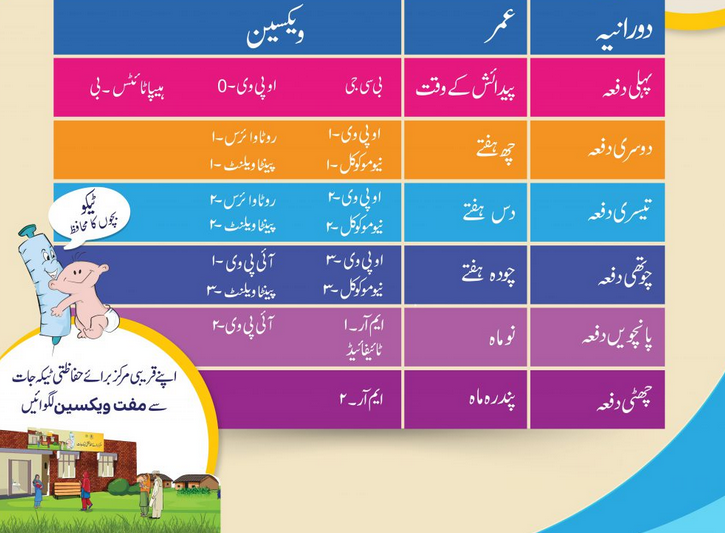Routine Immunization Coverage and Immunization Card Retention in Pakistan: Results From a Cross-sectional National Survey

The Aga Khan University (Hussain, Khan, Ahmed, Umer, Ansari, Soofi, Bhutta); Biostat Global Consulting (Rhoda, Brustrom); Federal Directorate of Immunization, Pakistan (Shah, Yunus); independent consultant (Oelrichs)
"The immunization coverage rates provide a direction to strategize the progress to improve the vaccination rates in Pakistan. The country needs to outline the immediate and long-term actions to combat vaccine-preventable diseases, such as...deploying behavioral interventions as a cross-cutting strategy to improve awareness and reduce misconceptions."
Pakistan is one of two countries where polio is still endemic and ranks third in the world for having the highest number of unvaccinated children. Among the reasons for low immunisation coverage are lack of awareness among communities, low socioeconomic status and parental education, and gaps in vaccination service delivery. This study examines the national and provincial/regional coverage and determinants of fully, partially, and not-vaccinated children, as well as antigen-wise coverage, percentage of home-based vaccination records (HBR) retention, and reasons for nonretention, dropout, timeliness, and prevalence of missed opportunities for simultaneous vaccination (MOSV).
The survey was a descriptive cross-sectional national household survey carried out across Pakistan. The survey included 110,790 children 12-23 months old and their caregivers. A World Health Organization (WHO)—Expanded Program on Immunization (EPI) Survey questionnaire was adapted to collect information. Data were analysed using the WHO Vaccination Coverage Quality Indicators (VCQI) software and Stata version 17.
Nationally, excluding Azad Jammu and Kashmir (AJK) and Gilgit Baltistan (GB), the coverage of fully vaccinated children was 76.5%. The rate of full immunisation coverage was highest in the province of Punjab (90%) and lowest in Balochistan (37.7%). The likelihood of being fully vaccinated was higher among children of educated parents who belonged to higher wealth quintiles and resided in any province/region other than Balochistan. The main reasons for unimmunisation were no faith in immunisation, rumours about vaccines, and distance to the facility. However, these reasons were present in a very small percentage (less than 2%). Therefore, it is the researchers stress the need to take a comprehensive approach - i.e., improving demand- and supply-side interventions - to accelerate vaccination rates.
About two-thirds (66.2%) of the children had their HBR available. A vaccination card is a source of information and a reminder for caregivers. It is an effective tool for recording vaccines a child receives to track later. However, this survey underscored user-end behavioural and supply-end unavailability factors with the retention of cards. The main reasons for not showing immunisation cards across Pakistan were no awareness of the importance of the card (verbalised by 3.2% of the population), never visiting a facility (2.6%), and nonavailability of the card at a health facility at the time of visit (1.5%). Other reasons highlighted that a card was not provided by a healthcare provider (1.3%) and was unaware of any such card (1.3%). Per the researchers, it is imperative to highlight the importance of immunisation cards and their uses in terms of a physical reminder for a timely vaccine dose.
The cards indicate that a notable portion of doses for which the child's age could be calculated was given more than two months late, and the portion increased for doses later in the schedule. Of the 218,002 vaccination visits documented on HBR in the provinces, MOSV occurred in 17.6% of the visits.
The researchers note that most children in the sample for this survey were younger than 10 months when COVID-19 struck, so they may have had some routine immunisation services disrupted or delayed. However, compared with the national immunisation coverage rate reported in the 2018 Pakistan Demographic and Health Survey (PDHS), i.e., 65.6%, the rate found in this study shows an almost 10% increase.
In conclusion: "With polio still endemic, Pakistan must prioritize immediate and long-term strategies to improve immunization rates. Actions are required for low-coverage districts by intensifying immunization operations and expanding outreach activities to uncovered areas. The long-term actions should include behavioral change interventions to emphasize the importance of vaccination and the retention of vaccination cards for proper documentation from user and research perspectives."
The Pediatric Infectious Disease Journal 2023 Mar; 42(3): 260-70. doi: 10.1097/INF.0000000000003804. Image credit: Federal Directorate of Immunization, Pakistan
- Log in to post comments
